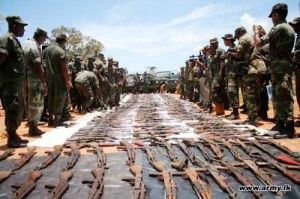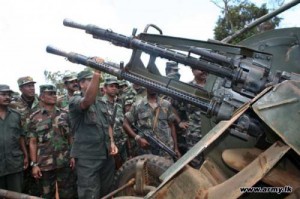Time was when Sri Lanka used to be known as the Granary of the East. Now, it may be dubbed the Armoury of the East.
Large caches of weapons continue to be detected from many areas which were once under LTTE control. The police said yesterday (July 22), they had unearthed a haul of over 2,500 kilos of high explosives in the Wanni. Disaster that the LTTE would have been able to wreak on the country with that amount of plastic explosives could be gauged from the Central Bank blast (1996), in which the LTTE used only 300 kilos of C-4 explosives. The amount of explosives the police and the armed forces have found over the past few months is sufficient to blow many nerve centres in the city out of sight several times over! Among the arms recovered are thousands of assault rifles and dozens of heavy guns with ammunition. The army said about four months ago it had found LTTE’s arms and ammunition worth over 20 million US dollars during operations in the Wanni.
 The detection of arms caches sheds light on Prabhakaran’s failed strategy of thwarting the army’s advance. He did not offer stiff resistance initially in the Wanni and retreated hiding as he did arms, ammunition, explosives and fuel in various places in the hope of making a comeback. Within weeks of the Wanni offensive, he summoned a group TNA MPs and asked them to bring international pressure to bear on the Rajapaksa government to stop war and promised to hold out until then.
The detection of arms caches sheds light on Prabhakaran’s failed strategy of thwarting the army’s advance. He did not offer stiff resistance initially in the Wanni and retreated hiding as he did arms, ammunition, explosives and fuel in various places in the hope of making a comeback. Within weeks of the Wanni offensive, he summoned a group TNA MPs and asked them to bring international pressure to bear on the Rajapaksa government to stop war and promised to hold out until then.
On the battlefield, Prabhakaran’s plan was to infiltrate the cleared areas and attack the army from behind with the hidden arms. But, it went awry as the government had prudently provided for such an eventuality. Unfortunately for him, international assistance was not forthcoming and he became too dependent on the forcibly evicted civilians for survival. After the fall of Kilinochchi, the capture of which, he had said, was a daydream of President Mahinda Rajapaksa, he was compelled to induct cadres in large numbers to curb the army’s march and lost, in the process, many of them.
President Rajapaksa said in a press interview recently that if he had been Prabhakaran and cornered, he would have resorted to guerrilla warfare. Prabhakaran could have done so before the army reached Mullaittivu. After losing Kilinochchi, he had his work cut out because he had to increase the pace of his retreat while sacrificing cadres and controlling a huge human shield, a task that required a great deal of manpower.
If Prabhakaran had gone into the guerrilla mode earlier and opened many shifting fronts by using buried arms caches, the war would have dragged on for a long time thus warranting foreign intervention. Perhaps, he and other top Tigers would have been able to escape in a protracted war. Instead, he underestimated the army’s capability to smash through numerous obstacles and advance rapidly and hoped for a Vadamarachchi type rescue operation or a last minute foreign intervention to halt the army’s march and force a ceasefire and a peace process on the government.
But, why on earth had Prabhakaran stockpiled so many arms and so much of ammunition and C-4 explosives in spite of having a relatively small fighting force at his disposal? Hadn’t the Navy sunk the LTTE’s floating arms warehouses, his lethal stocks would have increased manifold.
President Rajapaksa asked the same question while stumping Uva the other day. And his guess was that the LTTE arms stocks were sufficient to take on another country.
Prabhakaran may have wanted to arm some radical elements in Tamil Nadu with the help of the lunatic fringe there represented by the likes of Vaiko. Besides, the LTTE’s links with Assamese militants and Maoists have been established; during the last general election in India, Indian intelligence agencies warned of a possible Maoist-LTTE tie-up to disrupt polls.
Indian Prime Minister Dr. Manmohan Singh said in New Delhi last week that the overall health of Indo-Lanka ties depended on the welfare of Sri Lankan Tamils. His concern for Tamil IDPs should be appreciated and the Sri Lankan government needs to be kept on its toes. Therefore, such bold statements from New Delhi are salutary from a humanitarian point of view.
However, India must be thankful and grateful to Sri Lanka for having eliminated the LTTE, which had the potential to unleash anarcho-racist forces and set Tamil Nadu ablaze, as could be seen from the LTTE-instigated anti-Indian protests inside court houses in that state and the blatant desecration by pro-LTTE mobs of Rajiv and Nehru statues.
Courtesy : The Island